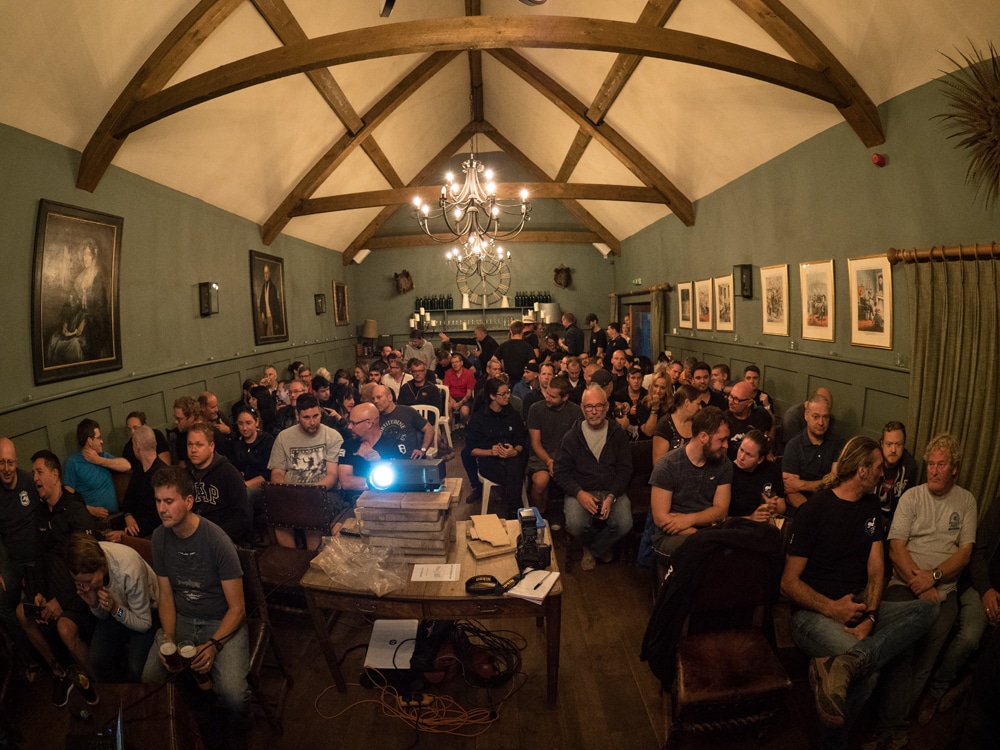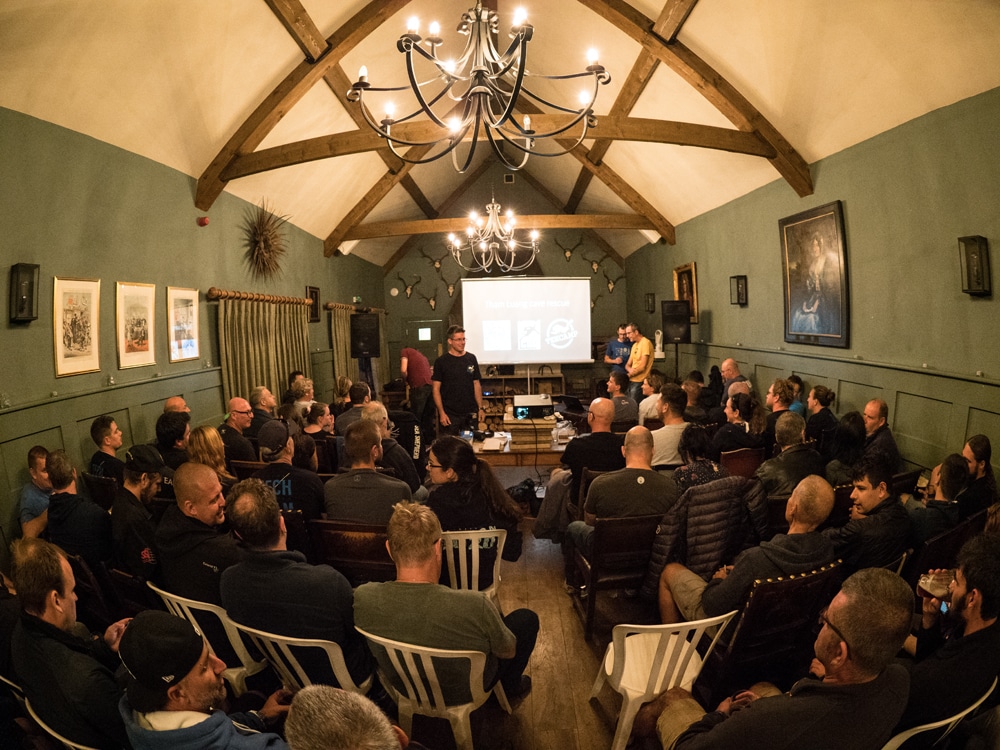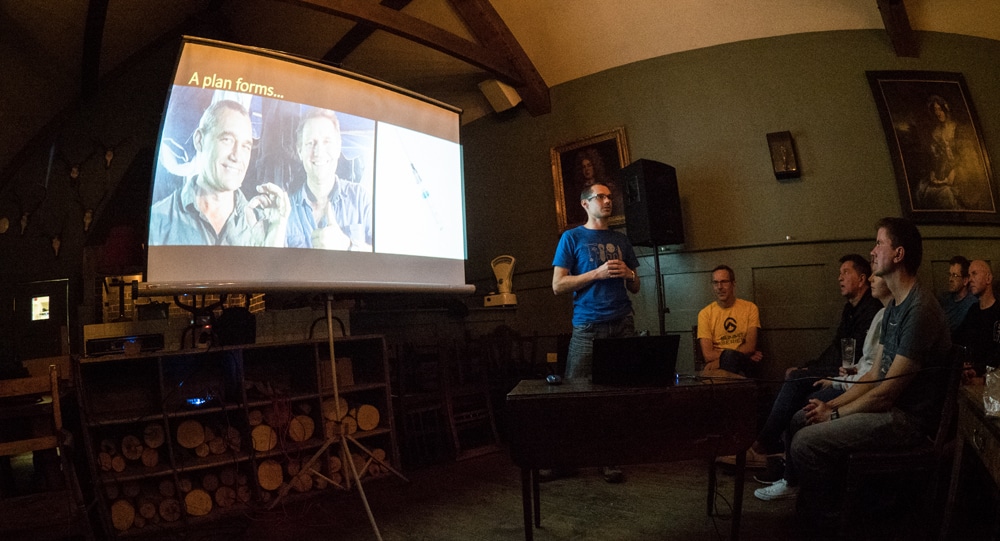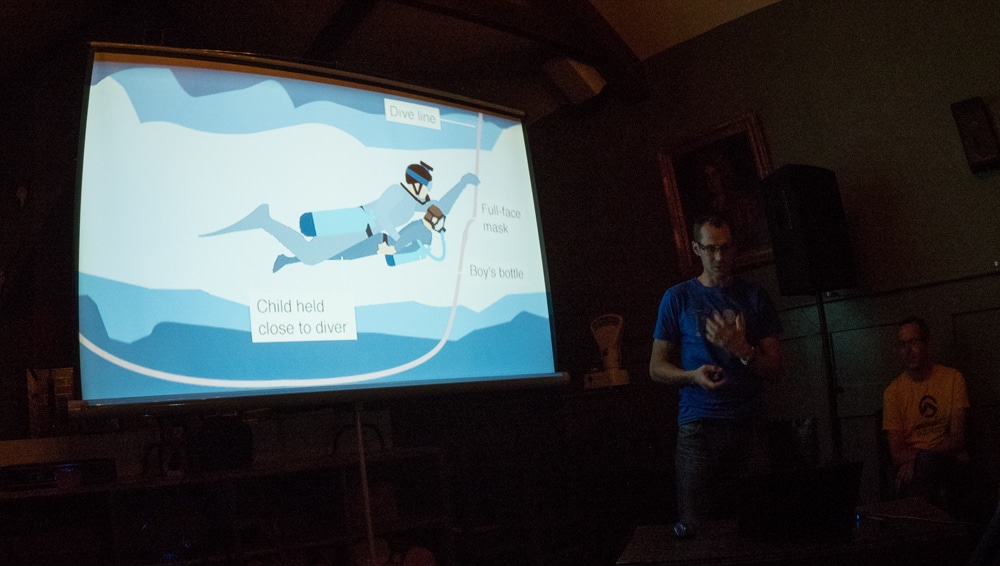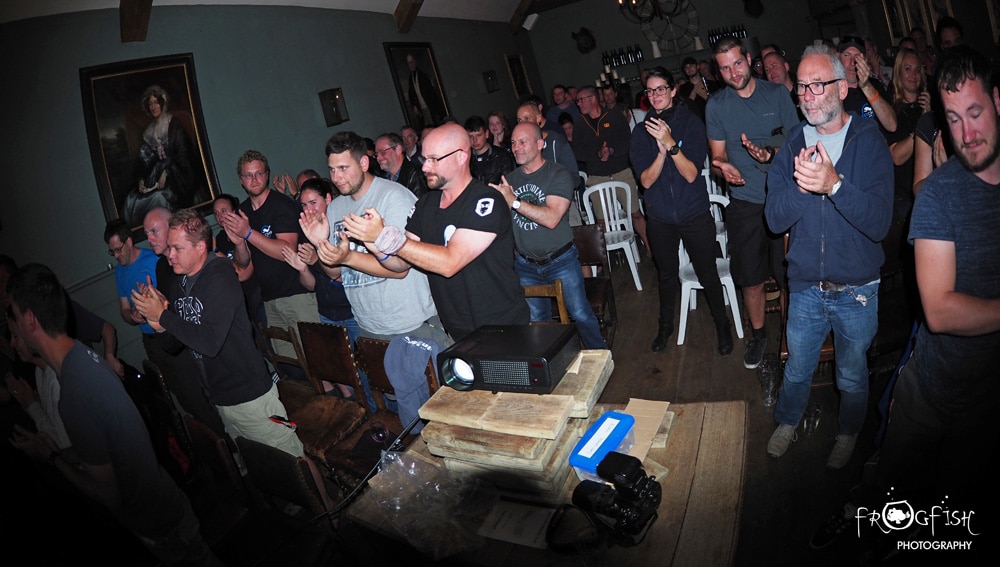News
Thailand Cave Rescue
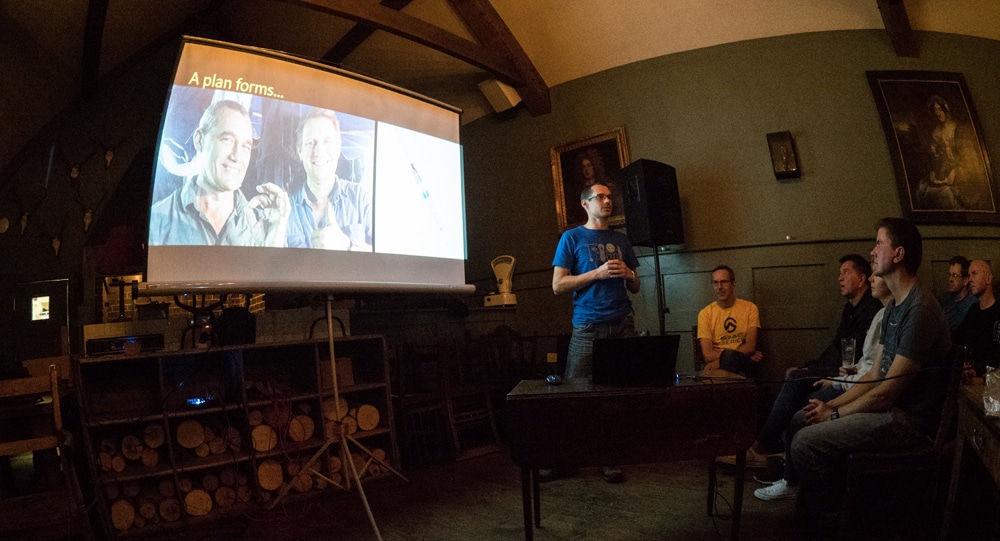
 Tham Luang Cave Rescue Talk at TekCamp 2018 Speakers: John Volanthen & Chris Jewell
Tham Luang Cave Rescue Talk at TekCamp 2018 Speakers: John Volanthen & Chris Jewell
There was a real buzz in the packed room in The Talbot Inn in Mells, Somerset, where divers gathered at the end of the first day of TekCamp 2018 to hear about the story that gripped the world earlier in the summer.
The room was packed, with standing room only as John and Chris took the stage. They were introduced by Tim Clements from Vobster Quay / TekCamp. We could not wait to hear, straight from the horse’s mouth, what had actually happened in those weeks in June and July when divers strove to rescue the young Thai football team and their coach.
John Volanthen started the talk, giving those attending a real feel for the task that lay ahead of the rescue team. The boys and their coach had ventured into the cave on a bright sunny day, with no indication of what might lie ahead of them. In fact, it was heavy rain the night before, that took 12 hours to seep through the hills and into the cave system, that was the cause a rapidly rising water cutting them off. As concern grew, so did the numbers in the rescue effort at the mouth of the cave system, but it was Vernon Unsworth, who lives in Thailand and was expecting to dive the cave system that very week, who saw the need to a specialist cave diving team to get there as soon as possible. John was one of the first to fly out, on the 26th July, along with Rick Stanton, and the two of them got straight off the plane and into the cave to check out the situation that faced them.
The water column kept on rising, at a rate that was visible to the naked eye. Something drastic was happening. More rain was falling, and this was torrential monsoon rain that brings huge amounts of water to the area in a short space of time. John described the dives as being something like “white water caving” such was the current they had to make progress against. Soon, the dry chambers at the mouth of the cave entrance were filling up too. But the rain did stop, and pumps worked day and night to try to bring down the water level in the various cave chambers.
The Thai Navy, who comprised experienced divers, but none with cave diving experience, took hundreds of cylinders to chamber 3. The US Para-Rescue team arrived and started co-ordinating the various rescue teams on the ground. The diving started up again, and the UK team decided that as there were lots of available cylinders and the cave system was shallow, they would use simple open-circuit dive gear for their search and rescue dives. After two more days of laying lines and progressing further into the caves, John and Rick surfaced in an air bell. Rick, who is “built for smelling”, detected a scent and as they looked around they suddenly saw people moving around and were overwhelmed when they confirmed that they had all 13 alive standing in front of them. “There is no training course that can prepare you for this!” They handed out spare lights and John promised they would come back for them. At Chamber 3, they handed video footage of the survivors to the Thai team, and before they got out of the cave system, the whole world knew what they had found!
It is at this point that Chris took over the talk, as it was this point in the story that he was called, whilst giving an early morning tv interview, to ask him to come out to Thailand ASAP and to bring over 300kg of kit with him. Just after Chris arrived, the tragic death of Thai Navy Seal, Saman Kunan, was announced. The UK divers were not on site at the time and did not know what happened. On Chris’ first full day in the region, he, along with Jason Mallinson, did a supply run to the kids, giving them a chance to experience for themselves the challenge ahead, along with taking the much-needed food rations to the survivors. That evening, a team of 3 UK surface controllers arrived, to help with the planning and co-ordination of the rescue. A plan was starting to form, and it involved full sedation using Ketamine, positive pressure full face masks and pure oxygen.
Before the rescue began, the boys (and their families) were told about the plan and agreed to it. The four British Divers would dive a boy each through the cave system, with an Australian anaesthetist giving the initial injection. At each point in the cave system where the divers would surface, more diving and medical specialists would be on hand to assist, but the underwater sections would be done as one cave diver with one boy. Diving unconscious kids through a cave system had never been done before, the risks were great, but there were no alternative options. “We knew it was a high risk rescue with a high probability of fatalities”.
The distance from Chamber 3 to the area where the boys were located was around 1.5km, with sections that were either fully,or part submerged. The kids themselves decided who got to go first, and so “the ones with the furthest cycle home” were the first to be rescued! The four UK divers: John Volanthen, Chris Jewell, Rick Stanton and Jason Mallinson began their rescue attempt with 3 cylinders for themselves, plus an O2 cylinder for the boy they would be rescuing. They ditched one of their tanks at the turning point, the kids would get themselves into their wetsuits, be sedated, and then carrying them facedown, they began their long journey back to Chamber 3. Once at Chamber 3, a medical team and the Thai Navy were there to rush them to the cave entrance and onto hospital.
The first day saw 4 boys being rescued to huge praise from everyone on site, and around the globe, but the team had to do it two more times. “We really didn’t believe we would have total success”.
John takes back the chair and continues the story at this point in proceedings. The final day dawned and they had 4 more boys and the coach to get back to safety. The rain had started, and it felt like “luck was on a razor edge”. The Americans had smuggled in KFC and Jack Daniels into Chamber 3 to celebrate with the dive team as they finished their amazing rescue. John reflected that their success was down to everyone there: military, cave divers and even the politicians who took hard decisions. “They trusted us and we didn’t let them down”.
This was without doubt the most incredible talk on diving we have ever been too. Well done to the TekCamp 2018 team for arranging it, and a huge thank you to John and Chris for their honest talk about an event that gripped the world for nearly 3 weeks. To get such a detailed insight into this rescue was amazing. The bravery shown by these two divers and all those that took part in this rescue is admirable and the fact that they were so humble in describing events made them seem even more like modern day super heroes that they clearly are.
For more on TekCamp visit the website by clicking here.
Blogs
Northern Red Sea Reefs and Wrecks Trip Report, Part 3: The Mighty Thistlegorm

Jake Davies boards Ghazala Explorer for an unforgettable Red Sea diving experience…
Overnight, the wind picked up, making the planned morning dive a bit bumpy on the Zodiacs to the drop point on Thomas Reef. There, we would dive along the reef before descending through the canyon and then passing under the arch before ascending the wall with a gentle drift. The site provided great encounters with more pelagic species, including shoals of large barracuda, tuna, and bigeye trevally.
Once back on the boat, it was time to get everything tied down again as we would head back south. This time, with the wind behind us, heading to Ras Mohammed to dive Jackfish Alley for another great gentle drift wall dive before then heading up the coast towards the Gulf of Suez to moor up at the wreck of the Thistlegorm. This being the highlight wreck dive of the trip and for many onboard, including myself, it was the first time diving this iconic wreck. I had heard so much about the wreck from friends, and globally, this is a must on any diver’s list. Fortunately for us, there was only one other boat at the site, which was a rarity. A great briefing was delivered by Ahmed, who provided a detailed background about the wreck’s history along with all the required safety information as the currents and visibility at the site can be variable.

Kitting up, there was a lot of excitement on deck before entering the water and heading down the shoreline. Descending to the wreck, there was a light northerly current which reduced the visibility, making it feel more like the conditions that can be found off the Welsh coast. At 10m from the bottom, the outline of the wreck appeared as we reached the area of the wreck which had been bombed, as our mooring line was attached to part of the propeller shaft. Arriving on deck, instantly everywhere you looked there were many of the supplies which the ship was carrying, including Bren Carrier tanks and projectiles that instantly stood out.

We headed around the exterior, taking a look at the large propeller and guns mounted on deck before entering the wreck on the port side to take a look in the holds. It was incredible to see all the trucks, Norton 16H, and BSA motorcycles still perfectly stacked within, providing a real snapshot in time.

Overall, we had four dives on the Thistlegorm, where for all of the dives we were the only group in the water, and at times, there were just three of us on the whole wreck, which made it even more special, especially knowing that most days the wreck has hundreds of divers. Along with the history of the wreck, there was plenty of marine life on the wreck and around, from big green turtles to batfish, along with shoals of mackerel being hunted by trevally. Some unforgettable dives.

The final leg of the trip saw us cross back over the Suez Canal to the Gobal Islands where we planned to stay the night and do three dives at the Dolphin House for the potential of sharing the dive with dolphins. The site, which included a channel that was teeming with reef fish, especially large numbers of goatfish that swam in large shoals along the edge of the reef. These were nice relaxing dives to end the week. Unfortunately, the dolphins didn’t show up, which was okay as like all marine life they are difficult to predict and you can’t guarantee what’s going to be seen. With the last dive complete, we headed back to port for the final night where it was time to clean all the kit and pack before the departure flight the next day.

The whole week from start to finish on Ghazala Explorer was amazing; the boat had all the facilities you need for a comfortable week aboard. The crew were always there to help throughout the day and the chefs providing top quality food which was required after every dive. The itinerary providing some of the best diving with a nice mixture of wreck and reef dives. I would recommend the trip to anyone, whether it’s your first Red Sea liveaboard in the Red Sea or you’re revisiting. Hopefully, it’s not too long before I head back to explore more of the Red Sea onboard Ghazala Explorer.

To find out more about the Northern Red Sea reef and wrecks itineraries aboard Ghazala Explorer, or to book, contact Scuba Travel now:
Email: dive@scubatravel.com
Tel: +44 (0)1483 411590
Photos: Jake Davies / Avalon.Red
Blogs
Northern Red Sea Reefs and Wrecks Trip Report, Part 2: Wall to Wall Wrecks

Jake Davies boards Ghazala Explorer for an unforgettable Red Sea diving experience…
The second day’s diving was a day full of wreck diving at Abu Nuhas, which included the Chrisoula K, Carnatic, and Ghiannis D. The first dive of the day was onto the Chrisoula K, also known as the wreck of tiles. The 98m vessel remains largely intact where she was loaded with tiles which can be seen throughout the hold. The stern sits at 26m and the bow just below the surface. One of the highlights of the wreck is heading inside and seeing the workroom where the machinery used for cutting the tiles are perfectly intact. The bow provided some relaxing scenery as the bright sunlight highlighted the colours of the soft coral reef and the many reef fish.

Following breakfast, we then headed to the next wreck, which was the Carnatic. The Carnatic is an 89.9m sail steamer vessel that was built in Britain back in 1862. She ran aground on the reef back in 1869 and remains at 27m. At the time, she was carrying a range of items, including 40,000 sterling in gold. An impressive wreck where much of the superstructure remains, and the two large masts lay on the seafloor. The wooden ribs of the hull provide structures for lots of soft corals, and into the stern section, the light beams through, bouncing off the large shoals of glass fish that can be found using the structure as shelter from the larger predators that are found outside of the wreck.

The final wreck at Abu Nuhas was the Ghiannis D, originally called ‘Shoyo Maru,’ which was 99.5m long and built in Japan back in 1969 before becoming a Greek-registered cargo ship in 1980. The ship then ran aground on the reef on April 19th, 1983, and now sits at the bottom at a depth of 27m. Heading down the line, the stern of the ship remains in good condition compared to the rest of the hull. The highlight of the wreck, though, is heading into the stern section and down the flights of stairs to enter the engine room, which remains in good condition and is definitely worth exploring. After exploring the interior section of the ship, we then headed over to see the rest of the superstructure, where it’s particularly interesting to see the large table corals that have grown at the bow relatively quickly considering the date the ship sank. After surfacing and enjoying some afternoon snacks, we made sure everything was strapped down and secured as we would be heading north and crossing the Gulf of Suez, where the winds were still creating plenty of chop.

The next morning, it was a short hop to Ras Mohammed Nature Reserve for the next couple of days of diving. The 6am wake-up call came along with the briefing for the first site we would be diving, which was Shark & Yolanda. The low current conditions allowed us to start the dive at Anemone City, where we would drift along the steep, coral-filled wall. These dives involved drifts, as mooring in Ras Mohammed wasn’t allowed to protect the reefs. As a dive site, Shark & Yolanda is well-known and historically had a lot of sharks, but unfortunately not so many in recent years, especially not so early in the season. However, there was always a chance when looking out into the blue.

The gentle drift took us along the steep walls of the site, with plenty of anemone fish to be seen and a huge variety of corals. It wasn’t long into the dive before we were accompanied by a hawksbill turtle, who drifted with us between the two atolls before parting ways. Between the two reefs, the shallow patch with parts of coral heads surrounded by sand provided the chance to see a few blue-spotted stingrays that were mainly resting underneath the corals and are always a pleasure to see. With this being the morning dive, the early sunlight lit up the walls, providing tranquil moments. Looking out into the blue, there was very little to be seen, but a small shoal of batfish shimmering underneath the sunlight was a moment to capture as we watched them swim by as they watched us.

Towards the end of the dive, we stopped at the wreck of the Jolanda where the seafloor was scattered with toilets from the containers it was carrying. This provided a unique site to make a safety stop, which was also accompanied by a large barracuda slowly swimming by, along with a hawksbill turtle calmly swimming over the reef as the sun rays danced in the distance.
For the next dive, we headed north to the Strait of Tiran to explore the reefs situated between Tiran Island and Sharm El Sheik, which were named after the British divers who had found them. We started on Jackson before heading to Gordons Reef, where we also did the night dive. All the atolls at these sites provided stunning, bustling coral reefs close to the surface and steep walls to swim along, which always provided the opportunity to keep an eye out for some of the larger species that can be seen in the blue. Midwater around Jackson Reef was filled with red-toothed triggerfish and shoals of banner fish, which at times were so dense that you couldn’t see into the blue. Moments went by peacefully as we enjoyed the slow drift above the reef, watching these shoals swim around under the mid-afternoon sun.

The night dive at Gordon’s Reef was mainly among the stacks of corals surrounded by sand, which was great to explore under the darkness. After some time circling the corals, we came across what we were really hoping to find, and that was an octopus hunting on the reef. We spent the majority of the dive just watching it crawl among the reef, blending into its changing surroundings through changes in colour and skin texture. It’s always so fascinating and captivating to watch these incredibly intelligent animals, in awe of their ability to carry out these physical changes to perfectly blend into the reef. Before we knew it, it was time to head back to the boat to enjoy a well-deserved tasty dinner prepared by the talented chefs onboard.
Check in for the 3rd and final part of this series from Jake tomorrow!
To find out more about the Northern Red Sea reef and wrecks itineraries aboard Ghazala Explorer, or to book, contact Scuba Travel now:
Email: dive@scubatravel.com
Tel: +44 (0)1483 411590
Photos: Jake Davies / Avalon.Red
-

 News3 months ago
News3 months agoHone your underwater photography skills with Alphamarine Photography at Red Sea Diving Safari in March
-

 News3 months ago
News3 months agoCapturing Critters in Lembeh Underwater Photography Workshop 2024: Event Roundup
-

 Marine Life & Conservation Blogs2 months ago
Marine Life & Conservation Blogs2 months agoCreature Feature: Swell Sharks
-

 Blogs2 months ago
Blogs2 months agoMurex Resorts: Passport to Paradise!
-

 Blogs2 months ago
Blogs2 months agoDiver Discovering Whale Skeletons Beneath Ice Judged World’s Best Underwater Photograph
-

 Gear Reviews3 months ago
Gear Reviews3 months agoGear Review: Oceanic+ Dive Housing for iPhone
-

 Marine Life & Conservation2 months ago
Marine Life & Conservation2 months agoSave the Manatee Club launches brand new webcams at Silver Springs State Park, Florida
-

 News3 months ago
News3 months agoWorld’s Best Underwater Photographers Unveil Breathtaking Images at World Shootout 2023


